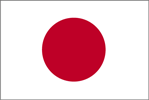| COUNTRY FACTS: JAPAN | |
|---|---|
| Name(official): | Japan (local long form: Nihon-koku/Nippon-koku) |
| Name(short): | Japan (local short form: Nihon/Nippon) |
| Capital City: | Tokyo |
| Location: | Eastern Asia, island chain between the North Pacific Ocean and the Sea of Japan, east of the Korean Peninsula Click to enlarge Map of Japan |
| Coordinate: | 36 00 N, 138 00 E |
| Independence: | 660 B.C. (traditional founding by Emperor JIMMU) |
| President: |
|
| Type of Government: | constitutional monarchy with a parliamentary government |
| Total Area: | Total: 377,835 sq km land: 374,744 sq km water: 3,091 sq km note: includes Bonin Islands (Ogasawara-gunto), Daito-shoto, Minami-jima, Okino-tori-shima, Ryukyu Islands (Nansei-shoto), and Volcano Islands (Kazan-retto) |
| Population: | 127,463,611 (July 2006 est.) |
| People: | Japanese 99%, others 1% (Korean 511,262, Chinese 244,241, Brazilian 182,232, Filipino 89,851, other 237,914) note: up to 230,000 Brazilians of Japanese origin migrated to Japan in the 1990s to work in industries; some have returned to Brazil (2004) |
| Religion: | Observe both Shinto and Buddhist 84%, other 16% (including Christian 0.7%) |
| Languages: | Japanese |
| Literacy: | definition: age 15 and over can read and write Total population: 99% male: 99% female: 99% (2002) |
| Currency: | Yen (JPY) |
| GDP(per capita): | $33,100 (2006 est.) |
| Arable Land: | 11.64% permanent crops: 0.9% other: 87.46% (2005) |
| Agriculture: | rice, sugar beets, vegetables, fruit; pork, poultry, dairy products, eggs; fish. |
| Industries: | Among world's largest and technologically advanced producers of motor vehicles, electronic equipment, machine tools, steel and nonferrous metals, ships, chemicals, textiles, processed foods |
| Natural resources: | negligible mineral resources, fish. |
| Japan Embassies in Africa: | Embassies of Japan |
| General Info: | Web-Japan |
| International Phone Code: | +81 |
| Scholarships: | Japanese Government Scholarships for Foreign Students |
ECONOMY: BUSINESS, TRADE AND INVESTMENT
Government-industry cooperation, a strong work ethic, mastery of high technology, and a comparatively small defense allocation (1% of GDP) helped Japan advance with extraordinary rapidity to the rank of second most technologically powerful economy in the world after the US and the third-largest economy in the world after the US and China, measured on a purchasing power parity (PPP) basis. One notable characteristic of the economy has been how manufacturers, suppliers, and distributors have worked together in closely-knit groups called keiretsu. A second basic feature has been the guarantee of lifetime employment for a substantial portion of the urban labor force. Both features have now eroded. Japan's industrial sector is heavily dependent on imported raw materials and fuels. The tiny agricultural sector is highly subsidized and protected, with crop yields among the highest in the world. Usually self sufficient in rice, Japan must import about 60% of its food on a caloric basis. Japan maintains one of the world's largest fishing fleets and accounts for nearly 15% of the global catch. For three decades, overall real economic growth had been spectacular - a 10% average in the 1960s, a 5% average in the 1970s, and a 4% average in the 1980s. Growth slowed markedly in the 1990s, averaging just 1.7%, largely because of the after effects of overinvestment and an asset price bubble during the late 1980s that required a protracted period of time for firms to reduce excess debt, capital, and labor. From 2000 to 2001, government efforts to revive economic growth proved short-lived and were hampered by the slowing of the US, European, and Asian economies. In 2002-06, growth improved and the lingering fears of deflation in prices and economic activity lessened. Japan's huge government debt, which totals 176% of GDP, and the aging of the population are two major long-run problems. Some fear that a rise in taxes could endanger the current economic recovery. Debate also continues on the role of and effects of reform in restructuring the economy, particularly with respect to the 2007-2017 privatization of Japan Post, which has functioned not only as the national postal delivery system but also, through its banking and insurance facilities, as Japan's largest financial institution.
MAJOR CITIES
Tokyo, Yokohama, Osaka, Nagoya, Sapporo, Kobe, Kyoto, Fukuoka, kawasaki, Sendai,
.....More Cities Of Japan
NEWS
INTERNATIONAL ORGANIZATIONS:
AfDB, APEC, APT, ARF, AsDB, ASEAN (dialogue partner), Australia Group, BIS, CE (observer), CERN (observer), CP, EAS, EBRD, FAO, G-5, G-7, G-8, G-10, IADB, IAEA, IBRD, ICAO, ICC, ICRM, IDA, IEA, IFAD, IFC, IFRCS, IHO, ILO, IMF, IMO, Interpol, IOC, IOM, IPU, ISO, ITU, ITUC, LAIA, MIGA, NEA, NSG, OAS (observer), OECD, OPCW, OSCE (partner), Paris Club, PCA, PIF (partner), SAARC (observer), SECI (observer), UN, UN Security Council (temporary), UNCTAD, UNDOF, UNESCO, UNHCR, UNIDO, UNITAR, UNMOVIC, UNRWA, UNWTO, UPU, WCL, WCO, WFTU, WHO, WIPO, WMO, WTO, ZC
GOVERNMENT: ADMINISTRATIVE UNITS
47 prefectures; Aichi, Akita, Aomori, Chiba, Ehime, Fukui, Fukuoka, Fukushima, Gifu, Gunma, Hiroshima, Hokkaido, Hyogo, Ibaraki, Ishikawa, Iwate, Kagawa, Kagoshima, Kanagawa, Kochi, Kumamoto, Kyoto, Mie, Miyagi, Miyazaki, Nagano, Nagasaki, Nara, Niigata, Oita, Okayama, Okinawa, Osaka, Saga, Saitama, Shiga, Shimane, Shizuoka, Tochigi, Tokushima, Tokyo, Tottori, Toyama, Wakayama, Yamagata, Yamaguchi, Yamanashi


